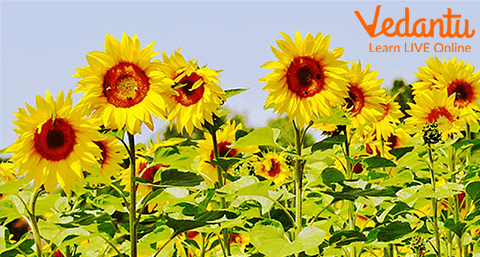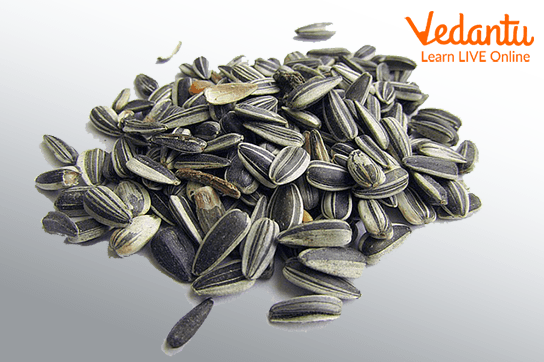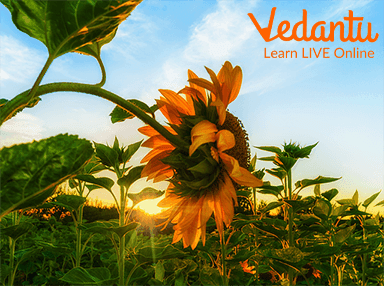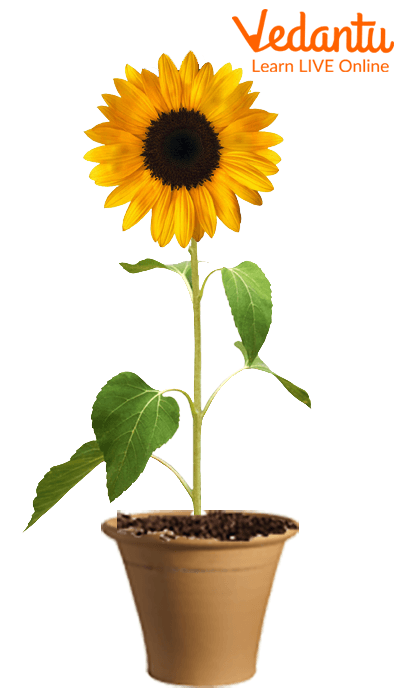




Information About Sunflower
Sunflowers is one of the most well known flowers, it is specifically known for its ability to show movement based on the sun’s movement. Sunflowers bloom at sunrise and keep blooming for a long time and beautifying the garden. Its flowers also give a good glow to the vase. Although the flowers are odourless, their colour is so bright that even two twigs in the vase look attractive.
Description of Sunflower
Sunflowers are one of the most beautiful flowers in the world. A welcome sight in any garden's sheer splendour and meadows of wildflowers, they signal the arrival of the long summer months, creating positivity and warmth with their bright sun-like appearance." The sunflower looks very attractive, but it is odourless.

The Sunflowers.
It is an annual plant of large proportions, reaching more than 3 metres in height. It is a plant with few branches, and the stem is thick, straight and large. It has deep roots formed from one main root and abundant secondary roots. Its leaves, 5 to 30 cm long and half as wide, are large, oval, carefully toothed, leafy, with three main veins and rough to the touch.
The upper leaves are alternate, and the lower leaves are opposite. The inflorescence, also known as the flower head, is large, 10 to 30 cm in diameter and contains hundreds of small tubular flowers.
In the outer part, we can find ligula or external sterile flowers in one or two rows which look like petals. These flowers, which appear from summer to fall, are golden yellow and have no direct reproductive function, but they act as an attraction for insects, which help the plant in the process of pollination.
The fertilised flowers develop in their receptacle – in the same provision as the honeycomb – into one of the most popular oleaginous fruits in the world: the "sunflower seeds". They are angular achenes, 8–15 mm long, oval, and flattened, with the pericarp (or outer covering) glossy black, white or striped, depending on the variety.
When the plant is fertilised, when mature, it has between 250 and 1500 flower heads, depending on its size and the number of flower heads the plant has. Plants with only one inflorescence have a higher seed content, whereas plants with multiple flowers have fewer seeds.
The back of the flower head is composed of a series of stem-like green segments. The flower head presents the heliotropic motion produced by rotating the stem in a nurturing process. In the evening, the stem gradually returns to its upright position. At maturity of the sunflower plant, that is, when it does not produce many seeds (from 35–40 days after flowering), the back of the flower head turns yellow and its bracts turn brown.
Scientific Name of Sunflower
The scientific name of the sunflower is Helianthus annuus.
Sunflower Movement Along with Sun
In the morning, all sunflowers will face east, in the direction of the rising sun. As the sun moves, so will the sunflower. But as summer turns into autumn and sunflowers get big, ripe, and heavy with seeds, they'll stop moving. Unless they are bitten, they will only face east. Sunflowers show phototropic movement.
Uses and Facts of Sunflower
Uses: Sunflowers' roots, leaves, flowers, and seeds have so many nutritional properties that sunflower is used as medicine in Ayurveda. In many diseases, sunflower is used as a medicine. Sunflowers' seeds are used to make oil, which is full of nutrients.

Sunflower Seeds.
Interesting Facts About Sunflower
The sunflower always faces toward the sun.
The sunflower plant is 1 to 4 metres tall, but in good soil, it grows up to 5 metres.
Sunflower stems are weak, there is a fear of them breaking due to wind, so farmers keep supporting the plants with wood.
The sunflower moves slowly along with the sun in its direction.
Sunflowers lose their heliotropic ability(plants move towards the sun) at the time of bloom, and the stem becomes stagnant. Typically in an easterly orientation, the stem and leaves lose their green colour.
Sunflowers are found in many colours, but most of them have yellow coloured flowers.
Ukraine's National flower is the Sunflower.

A Sunflower Tilted Towards the Sun.
How to Grow a Sunflower?
The best method of sowing sunflower seeds:
First, take a pot/container as you prefer with drainage holes at the bottom.
Fill the container pots with good quality organic compost to soil with a 2:1 ratio.
Sow 2 seeds in the centre of a pot.
Press the seeds slightly into the soil with your fingers (do this gently or the seed will damage) and cover them completely with the surrounding soil.
Lastly, sown seeds should be watered regularly.

Grow a Sunflower in a Pot.
Solved Questions
1. Write two facts about Sunflowers.
Ans: Facts about Sunflowers are:
The sunflower moves slowly along with the sun in its direction.
The National Flower of Ukraine is the Sunflower.
2. Write two uses for Sunflowers.
Ans: Uses of Sunflowers:
Extracted oil from the seeds of Sunflowers.
The Sunflower is used as medicine in Ayurveda. It can cure many diseases.
Learning By Doing
Write True or False.
Sunflowers are always orange in colour.
Sunflowers are odourless.
The scientific name of the sunflower is Helianthus Annuus.
Sunflowers are not used as medicine.
Summary
The sunflower is a very beautiful and attractive flowery plant. This comes in various colours and sizes. The most common colour is yellow. We can also extract oil from their seeds. It can cure many diseases.
In this chapter, we have studied many things related to Sunflowers. Now, you must have understood what a Sunflower is, its facts and uses, and many other important things.
FAQs on Sunflower Facts for Kids
1. What are some fun and interesting facts about sunflowers for kids?
Sunflowers are amazing plants with many interesting features. Here are a few fun facts:
- They follow the sun! Young sunflowers display a special behaviour called heliotropism, where their flower heads turn to follow the sun across the sky from east to west.
- They are not just one flower. A sunflower's large head is actually made up of thousands of tiny flowers called florets.
- They can grow very tall. Some varieties of sunflowers can grow taller than a person, sometimes reaching over 10 feet high!
- They have many uses. We get healthy cooking oil and tasty snacks (sunflower seeds) from them.
2. What are the main parts of a sunflower plant?
A sunflower plant has several important parts, just like other plants. The main ones to know for a school project are: the roots, which hold the plant in the ground and drink water; the stem, which is the strong, tall stalk that holds the plant up; the leaves, which soak up sunlight to make food; and the flower head, which is the big, bright yellow part that makes the seeds.
3. Why is a sunflower called a “sunflower”?
A sunflower gets its name for two main reasons. First, its big, round, yellow flower head looks just like a drawing of the sun. Second, it is famous for turning its head to follow the sun during the day. This connection to the sun makes “sunflower” the perfect name for it.
4. How do sunflowers actually follow the sun?
Young sunflowers follow the sun because of a process called heliotropism. The plant has an internal clock that helps it anticipate the sunrise. During the day, hormones cause the side of the stem away from the sun to grow slightly faster, making the flower head bend towards the light. Overnight, the process reverses so the flower head is facing east again, ready for the morning sun.
5. Is a sunflower head one big flower or many small ones?
This is a common misconception! A sunflower head is not a single flower. It's a composite flower, which means it is a collection of hundreds or even thousands of tiny flowers called florets packed together. The bright yellow “petals” on the outside are called ray florets, while the dark centre is made of disc florets, which later turn into seeds.
6. What are the different uses of a sunflower?
Sunflowers are very useful plants. Their seeds are a popular and healthy snack, full of vitamins. These seeds are also pressed to create sunflower oil, which is used for cooking all around the world. Even the leftover parts of the plant can be used as food for animals, making the entire plant very valuable.
7. What kind of place is best for a sunflower to grow?
Sunflowers love the sun, so they grow best in places that get at least 6 to 8 hours of direct sunlight every day. They also need soil that is not too wet. In India, states with plenty of sunshine like Karnataka and Andhra Pradesh are major producers of sunflowers because they provide the perfect conditions for these bright, happy plants to thrive.









